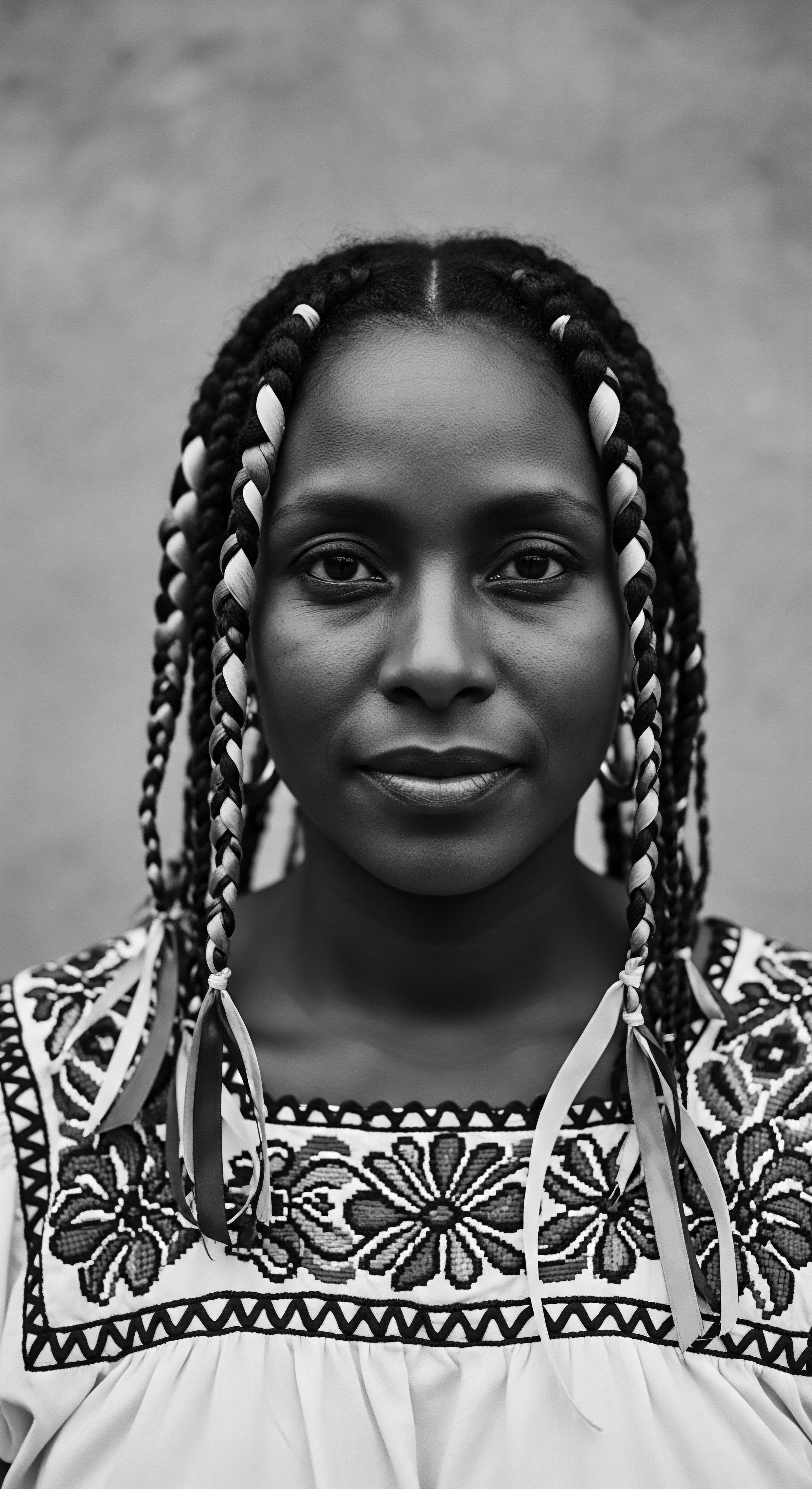
Roots
To walk the path of understanding textured hair is to listen to the whispers of the earth, to feel the ancient rhythms that shaped not only our bodies but also the very strands that spring from our scalps. For generations uncounted, across vast continents and through the intricate journeys of ancestral memory, certain elemental compounds—gifts from the soil itself—have served as silent guardians and devoted companions to kinky, coily, and wavy hair. These are not merely ingredients; they are echoes of an enduring heritage, substances drawn from the land that tell a story of resilience, ingenuity, and a profound connection between humanity and the ground beneath our feet.
Consider, for a moment, the Himba women of Namibia, whose distinctive red hair is a living testament to this ancestral bond. They coat their strands and skin with a paste called Otjize, a blend of red ochre, butterfat, and aromatic resin. This practice is not simply aesthetic; it symbolizes their connection to the earth and their ancestors, a daily ritual marking life stages and social standing. This earth compound, ochre, transforms hair into a canvas of identity, a visual link to their deep cultural roots.
What mineral composition within these compounds allowed them to function so intimately with the unique architecture of textured hair? This question guides our inquiry, inviting us to look beyond the surface of beauty practices and into the very heart of the earth’s contributions to our hair’s heritage.

The Earth’s Embrace
The specific earth compounds that nurtured textured hair heritage are primarily certain types of clays and mineral-rich soils. These substances, forged over millennia within the earth’s crust, possess unique molecular structures and mineral compositions that allowed them to interact harmoniously with the distinct morphology of kinky, coily, and wavy hair. The benefits ranged from cleansing and conditioning to protection and adornment, deeply intertwined with the daily lives and spiritual beliefs of diverse communities. These compounds offered a natural pharmacy, a living beauty cabinet, long before manufactured products came into being.
The earliest documented uses of clays for cosmetic purposes stretch back into prehistoric times. Ancient civilizations, recognizing the inherent properties of these earthly materials, integrated them into their daily routines. The very act of gathering, preparing, and applying these compounds became a ritual, a passing down of knowledge from one generation to the next. The continuity of these practices, even as they evolved, underscores the profound wisdom held within ancestral traditions.
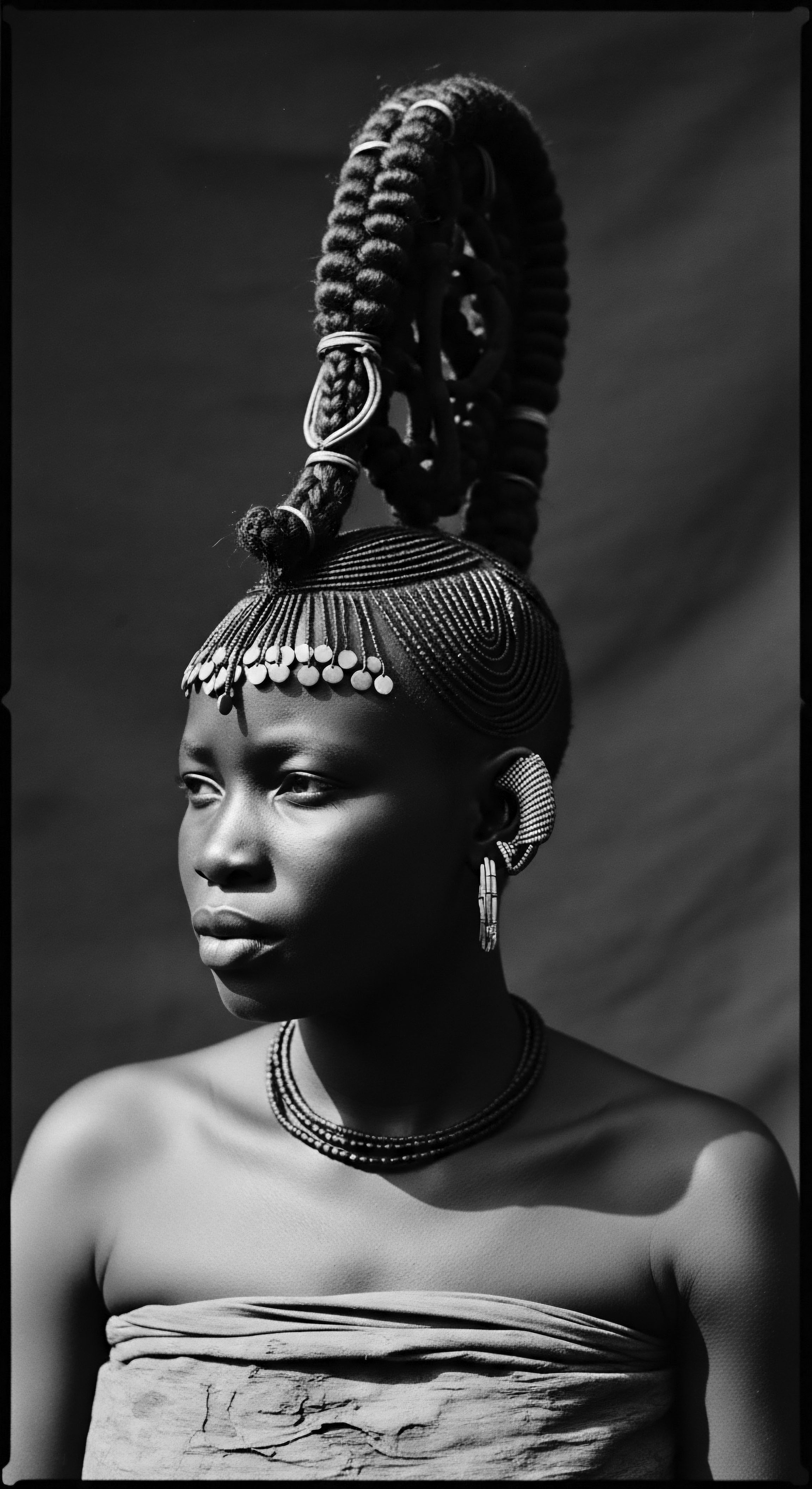
Understanding Earth’s Gifts
To appreciate how these compounds sustained textured hair, we must grasp their fundamental nature. Clays, at their core, are mineral-based, fine-grained soils, often originating from volcanic ash or sedimentary rock. Their efficacy lies in their unique ionic charges and expansive surface areas.
- Ionic Charge ❉ Many clays possess a negative charge, acting like a magnet for positively charged impurities, oils, and product buildup on the hair and scalp. This allows for effective cleansing without stripping the hair’s natural moisture.
- Adsorption and Absorption ❉ Clays can adsorb (attract and hold onto surfaces) and absorb (take into their structure) substances. When mixed with water, they swell, drawing out dirt and excess oils. This property makes them exceptional detoxifiers and clarifiers for textured hair, which can accumulate buildup due to its unique curl patterns.
- Mineral Content ❉ Beyond their cleansing abilities, these clays are rich in essential minerals like silica, magnesium, potassium, calcium, and iron. These minerals contribute to hair strength, scalp health, and overall vitality, providing a natural source of nourishment.
The interaction between these minerals and hair fibers is complex. For example, some minerals can form a protective film, while others may contribute to the hair’s structural integrity. The ancient wisdom, honed through empirical observation over countless generations, intuitively understood these properties, even without modern scientific nomenclature.
Earth compounds, born of millennia, provided ancestral textured hair with cleansing, protection, and nourishment.
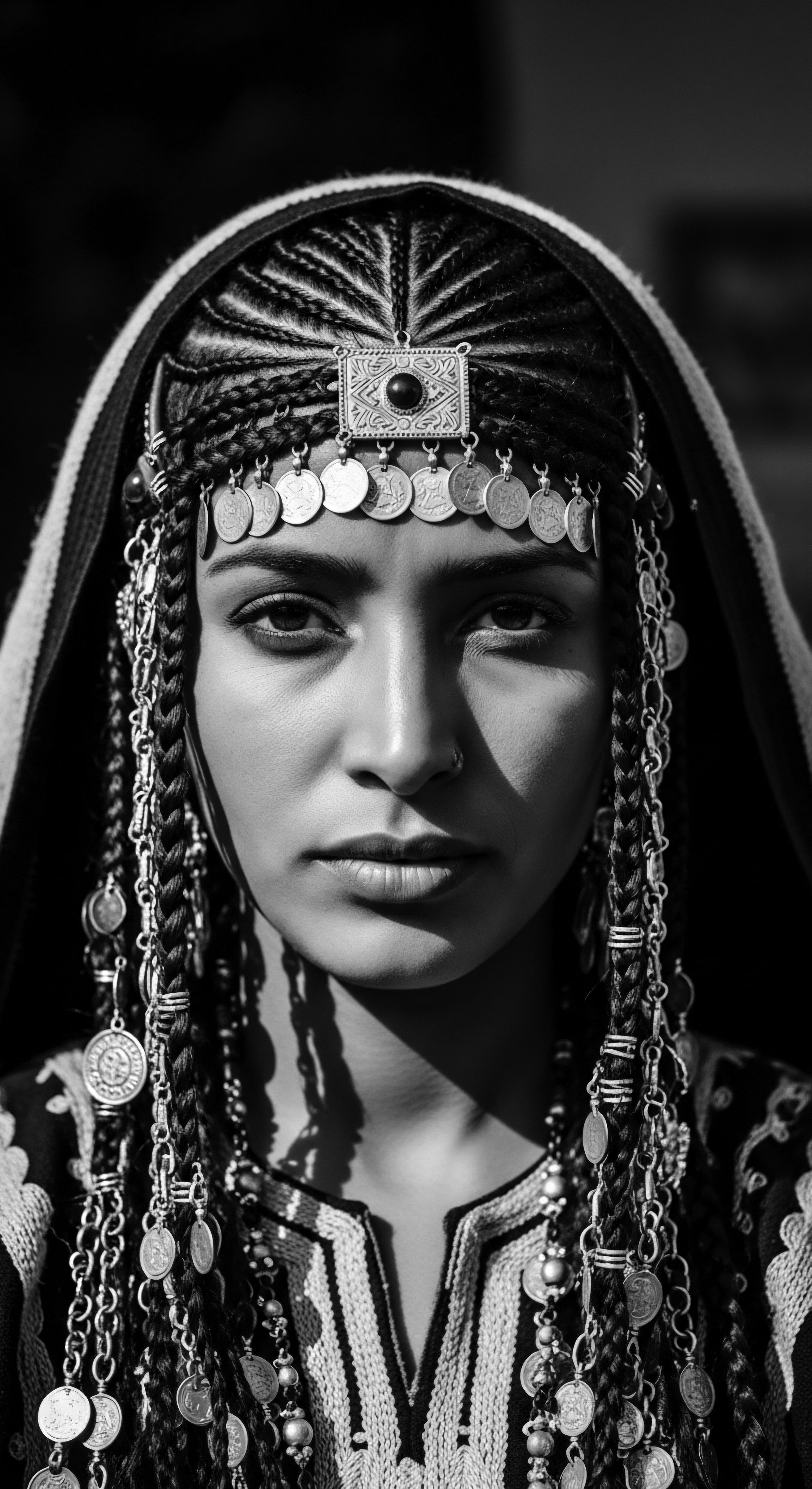
The Ancestral Pharmacy of Earth
Several key earth compounds stand out in their historical relationship with textured hair heritage. Their prevalence and continued use across various cultures speak volumes about their efficacy and cultural significance.
One such compound is Ochre, an earth pigment composed of ferric oxide, clay, and sand. Its hues range from yellow to deep red, and it was used extensively across Africa for body and hair adornment. The Himba people, for instance, have used red ochre for centuries, mixing it with animal fat to create the protective Otjize paste. This paste not only colors the hair but also protects it from sun damage and repels insects.
The use of ochre in hair, as exemplified by the Himba, is a profound cultural marker, communicating social status, age, and spiritual connection to the land. This practice highlights how earth compounds served not just a functional purpose, but a symbolic one, embodying identity and heritage.
Another significant category includes various types of cleansing clays. Rhassoul Clay, also known as Moroccan Lava Clay, hails from the Atlas Mountains of Morocco and holds a legacy dating back to the eighth century in Moroccan beauty practices. Rich in silica, magnesium, potassium, and calcium, this clay is renowned for its cleansing, absorbing, and degreasing properties.
It cleanses gently yet deeply, balances sebum secretion, and helps exfoliate dead cells, all while preserving the hair’s natural moisture barrier. Rhassoul clay’s historical application in traditional hammam rituals speaks to its enduring place in holistic care, passed down through generations.
Bentonite Clay, often called Montmorillonite clay, derives from volcanic ash and is known for its strong negative charge, making it a powerful detoxifier. It attracts positively charged impurities, product buildup, and mineral deposits from hard water, making it highly effective for clarifying textured hair. While modern scientific studies on its direct hair benefits are still growing, its historical use in alternative medicine across various cultures, including by Aboriginal and South American natives, suggests a long-standing recognition of its beneficial properties. In some regions, like Iran, bentonite clay has been a traditional hair cleanser for centuries.
Kaolin Clay, a white clay mineral, is also widespread and has been used for centuries in beauty products. Its gentle nature makes it suitable for hair care formulations aimed at oily scalps, absorbing excess oil without being overly drying. Its application in various indigenous communities, including Aboriginal and Torres Strait Islander peoples, for traditional medicines and body paint, points to its versatile and longstanding use.
These earth compounds were not isolated phenomena; they were interwoven with other natural elements and practices. For instance, the use of plant oils and butters, such as shea butter in West Africa, often accompanied clay treatments, providing essential moisture and protection to textured hair. This holistic approach, combining the earth’s minerals with botanical wisdom, sustained hair health across generations.

Ritual
The journey of textured hair care, especially through the lens of heritage, transcends simple application; it ascends to ritual. These earth compounds, drawn from the deepest parts of our planet, became central to ceremonies of cleansing, adornment, and spiritual connection. The way they were gathered, prepared, and applied mirrored the profound respect communities held for the natural world and for the symbolism encoded within each strand of hair.
What specific preparation methods transformed these raw earth compounds into sacred elixirs for hair? This question invites us to consider the alchemy of ancestral hands and the purposeful steps that precede true radiance.
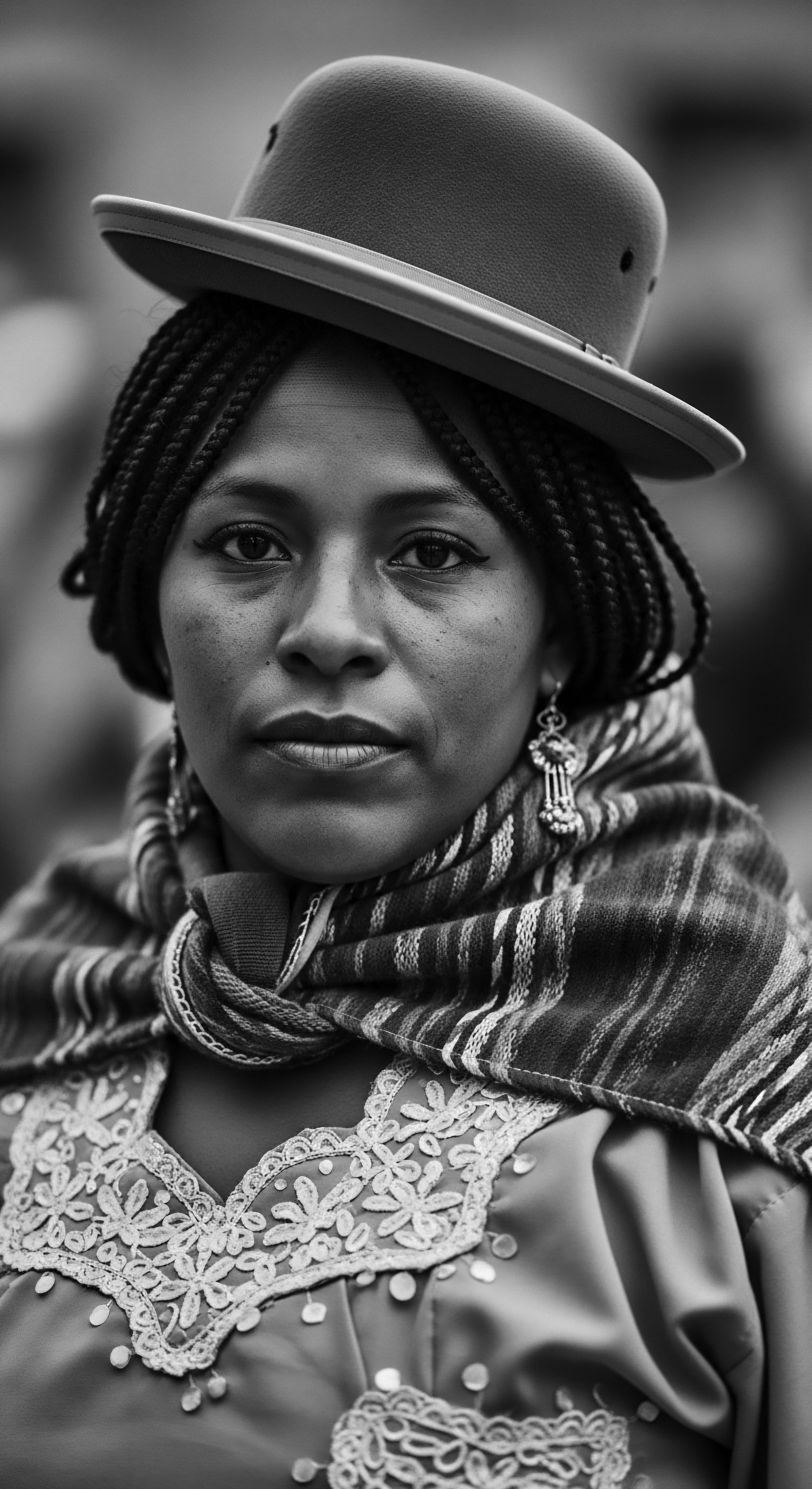
Handed Down Preparations
The preparation of earth compounds for hair care was rarely a hasty affair. It was often a deliberate, multi-step process, embodying patience and knowledge passed from elder to youth. This transmission of methods, often without written record, speaks to the strength of oral traditions and community learning, ensuring that the wisdom of the earth continued to serve subsequent generations.
For instance, the red ochre used by the Himba and Maasai peoples was not simply scooped from the ground and applied. It was typically ground into a fine powder, often using mortars and pestles, before being mixed with other ingredients like butterfat or animal fat. This grinding process ensured a smooth, consistent paste that adhered well to the hair and skin, maximizing its protective and cosmetic benefits. The careful mixing with fats provided a rich, emollient base that would condition the hair, offsetting any potential drying effects of the clay itself, a testament to practical knowledge of textured hair’s moisture needs.
Similarly, rhassoul clay, before its application as a purifying wash or mask, was traditionally mixed with water or sometimes hydrosols. The ratio of liquid to clay was critical to achieve the ideal consistency – a smooth, gel-like texture or a thicker mask that would cleanse effectively without creating tangles or leaving residue. In some practices, argan oil or other natural oils might be added after the clay treatment to seal in moisture and enhance shine, a practice still observed today.
| Earth Compound Red Ochre |
| Traditional Preparation Method Ground into powder, mixed with butterfat or animal fat. |
| Primary Heritage Benefit for Hair Protection from sun and insects, symbolic color, cultural identification. |
| Earth Compound Rhassoul Clay |
| Traditional Preparation Method Mixed with water to form a smooth paste; sometimes followed by argan oil. |
| Primary Heritage Benefit for Hair Gentle cleansing, sebum balance, ancestral purification. |
| Earth Compound Bentonite/Kaolin Clay |
| Traditional Preparation Method Mixed with water; sometimes combined with apple cider vinegar for pH balance. |
| Primary Heritage Benefit for Hair Detoxification, removal of buildup, scalp health. |
| Earth Compound These ancestral preparations reveal a deep understanding of natural chemistry and cultural reverence for hair. |

The Dance of Application
The application of these compounds was often a communal act, particularly for women, strengthening social bonds and transmitting cultural knowledge. Hair was rarely just hair; it was a sacred canvas, a medium for spiritual connection and communication with the ancestral world.
For example, in many West African societies, braiding techniques have a rich heritage, often performed by skilled braiders who held respected positions. The application of earth compounds would precede or follow these intricate styles, ensuring the hair was clean, pliable, and protected. The shared experience of hair styling, often taking hours, became a space for storytelling, education, and the reinforcement of identity.
The Fulani people, known for their thin, woven braids adorned with beads and cowrie shells, would have integrated such earth compounds into their care routines, which allowed for the creation and maintenance of these elaborate styles. The cowrie shells themselves, a symbol of wealth and prosperity, underscore how every aspect of hair adornment, including the earth compounds used, carried significant meaning within the cultural context.
Ancestral hands, guided by generations of wisdom, transformed earth’s gifts into vital elixirs through deliberate, communal ritual.

Beyond the Surface ❉ Spiritual Resonance
The use of earth compounds was not limited to physical benefits; it extended into the spiritual realm. In many African cultures, hair is perceived as a bridge between the living and the ancestral world, a conduit for spiritual energy. The top of the head was often considered the point of entry for divine energy. Thus, applying sacred earth compounds to the hair was a way to fortify this connection, to honor ancestors, and to invite blessings.
The incorporation of colored earths, like ochre, into hair rituals could also carry symbolic weight related to life, death, and rebirth. For some indigenous communities, including the Māori of New Zealand, creation narratives speak of humans coming from the red soil, making the application of red pigments a profound connection to their origins and lineage. This worldview elevates hair care from a mundane task to a sacred ceremony, where the very elements of the earth become agents of spiritual alignment.
This holistic understanding of hair—where its physical well-being is intertwined with spiritual and communal health—is a cornerstone of textured hair heritage. The compounds from the earth were not just conditioners; they were conduits of tradition, reminders of resilience, and expressions of an unbroken lineage.
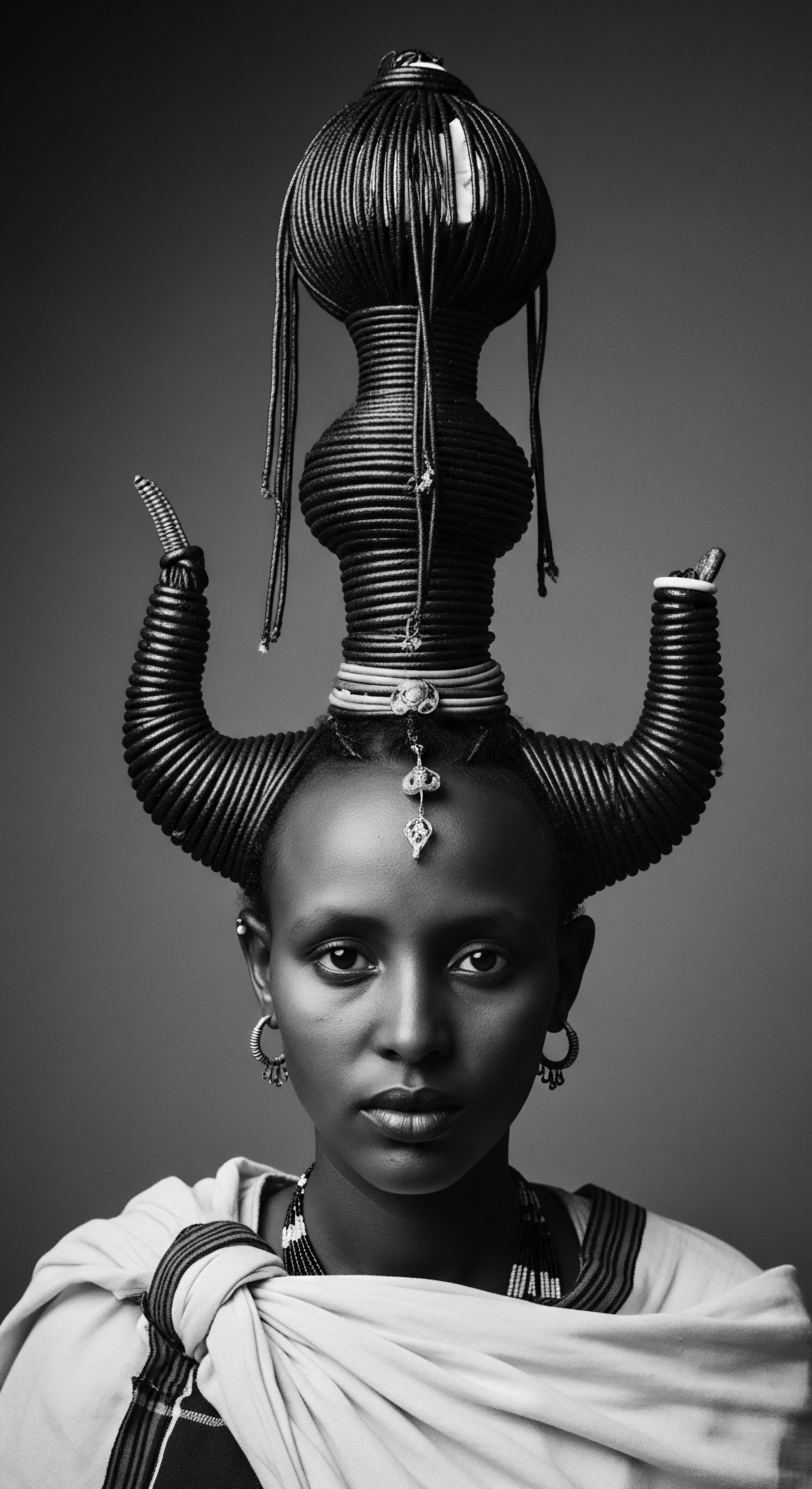
Relay
The ancestral wisdom surrounding earth compounds for textured hair has not vanished into the annals of history; it echoes in contemporary practices, a testament to its enduring efficacy and cultural resonance. The relay of this knowledge across generations, through diaspora, and into the modern world, demonstrates the resilience of heritage. How has modern science begun to validate these ancient practices, particularly concerning the mineral content of earth compounds and their effects on textured hair structure? This inquiry guides us into a deeper understanding of the scientific underpinnings that affirm what our ancestors intuitively knew.

Science Reflecting Ancestral Wisdom
The modern scientific lens, with its tools for chemical analysis and cellular investigation, is increasingly affirming the benefits observed by ancestral practitioners. Textured hair, with its unique helical structure and propensity for dryness, responds particularly well to the properties inherent in these earth compounds.
One of the primary benefits, understood instinctively by generations, is the cleansing action of clays without stripping natural oils. This is critical for textured hair, which benefits from retaining its natural sebum for moisture and elasticity. Scientific study shows that clays like bentonite and rhassoul possess significant ion-exchange capacities.
Bentonite, for instance, has a high cation exchange capacity, allowing it to effectively adsorb positively charged toxins, heavy metals, and product buildup from the hair shaft and scalp. This ‘detoxifying’ action cleanses the hair, leaving it lighter and more receptive to subsequent moisturizing agents.
The mineral composition of these clays also plays a more direct role in hair health. Rhassoul Clay, rich in silica, magnesium, and potassium, contributes to the hair’s overall vitality. Magnesium, for example, is a mineral vital for numerous bodily functions, and its topical application in historical contexts could have supported scalp health. While direct scientific studies on the specific mineral absorption from clay masks into hair follicles are limited, the anecdotal evidence from centuries of use points to observable benefits in hair texture, strength, and appearance.
Modern science reveals clays’ ancient wisdom, affirming their role in textured hair health through mineral composition and cleansing properties.

The Nutritional Interplay with Earth Minerals
Beyond external application, the broader impact of earth minerals on hair health extends to nutrition. While not directly ingested for hair care, the historical diets of communities with a strong textured hair heritage were often rich in mineral sources. These minerals, essential for overall bodily function, indirectly supported healthy hair growth. Hair follicles are among the most metabolically active cells in the body, requiring a steady supply of nutrients, including various minerals, for optimal growth.
Consider the general nutritional requirements for hair health:
- Iron ❉ Essential for oxygen transport to hair follicles; deficiency often correlates with hair loss. Many earth pigments, like red ochre, are iron oxides. While not a dietary source, their prevalence hints at the mineral richness of the environments where these cultures thrived.
- Zinc ❉ Plays a role in protein synthesis and cell division, both fundamental for hair growth. It also influences scalp health by regulating sebum production.
- Magnesium and Potassium ❉ Contribute to overall cellular function and hair strength. These are found abundantly in clays like rhassoul.
The long-standing reliance on local, unprocessed foods in ancestral diets meant a natural intake of these vital micronutrients from the soil, through plants and animals. This comprehensive approach – both external care with earth compounds and internal nourishment from mineral-rich diets – created a synergistic environment for robust hair growth and health within these heritage communities.
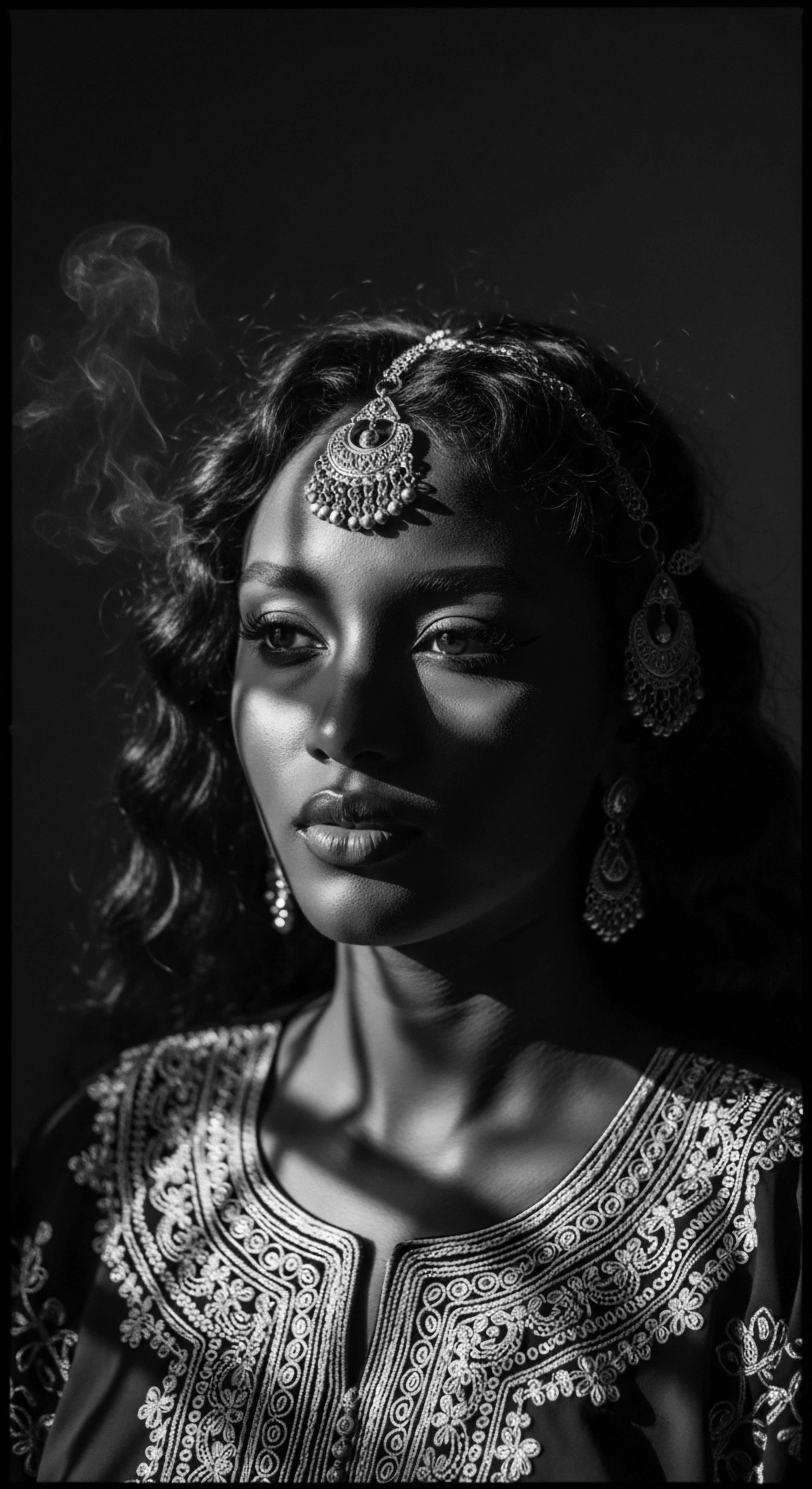
A Historical Example ❉ The Himba’s Otjize
The Himba people of Namibia offer a powerful example of the enduring connection between specific earth compounds and textured hair heritage. Their consistent application of Otjize, the red ochre paste, is a practice deeply ingrained in their cultural identity. Archaeological research indicates the use of ochre as a pigment for over 200,000 years in Africa. For the Himba, this practice transcends mere aesthetics.
A study by Dr. Riaan Francois Rifkin (2012 thesis, University of Witwatersrand) suggests that the red ochre applied by Himba women provides a significant degree of protection against UV rays, in addition to acting as a mosquito repellent. This demonstrates a sophisticated, ancestral understanding of both the cosmetic and practical benefits of earth compounds for skin and hair in a harsh desert environment.
The reddish tint of their hair, achieved through this compound, symbolizes their lineage, their connection to the earth, and their resilience. It stands as a profound illustration of how specific earth compounds directly nurtured textured hair heritage, preserving both the physical integrity of the hair and the cultural continuity of the people.
The continuity of this practice, from ancient times to the present day, underscores a living heritage. These earth compounds are not relics; they are active participants in a story that spans millennia, connecting past, present, and future through the reverence for hair. The relay of this ancestral knowledge, now sometimes amplified by modern scientific understanding, reinforces the truth that the earth has always provided for our textured strands.

Reflection
As we close this exploration into the specific earth compounds that nurtured textured hair heritage, we are left with a resonant truth ❉ the land holds memories, and those memories are often written upon our very beings, our hair included. The clays and mineral-rich soils were not just materials; they were silent witnesses to the unfolding story of Black and mixed-race hair, active participants in its preservation and celebration. From the ochre-painted strands of the Himba, speaking of lineage and resilience, to the cleansing rhassoul clay of Moroccan traditions, each earth compound echoes a profound relationship between humanity, the cosmos, and the self.
Our understanding of these ancestral practices deepens our appreciation for textured hair not merely as a biological marvel, but as a living archive. Every curl, every coil, every wave carries a history of care, a legacy of ingenuity, and a testament to the enduring human spirit that found sustenance and beauty in the elemental gifts of the earth. The ‘Soul of a Strand’ truly resides in this continuous connection, a lineage unbroken, inviting us to honor the earth beneath our feet as we honor the hair that crowns our heads.
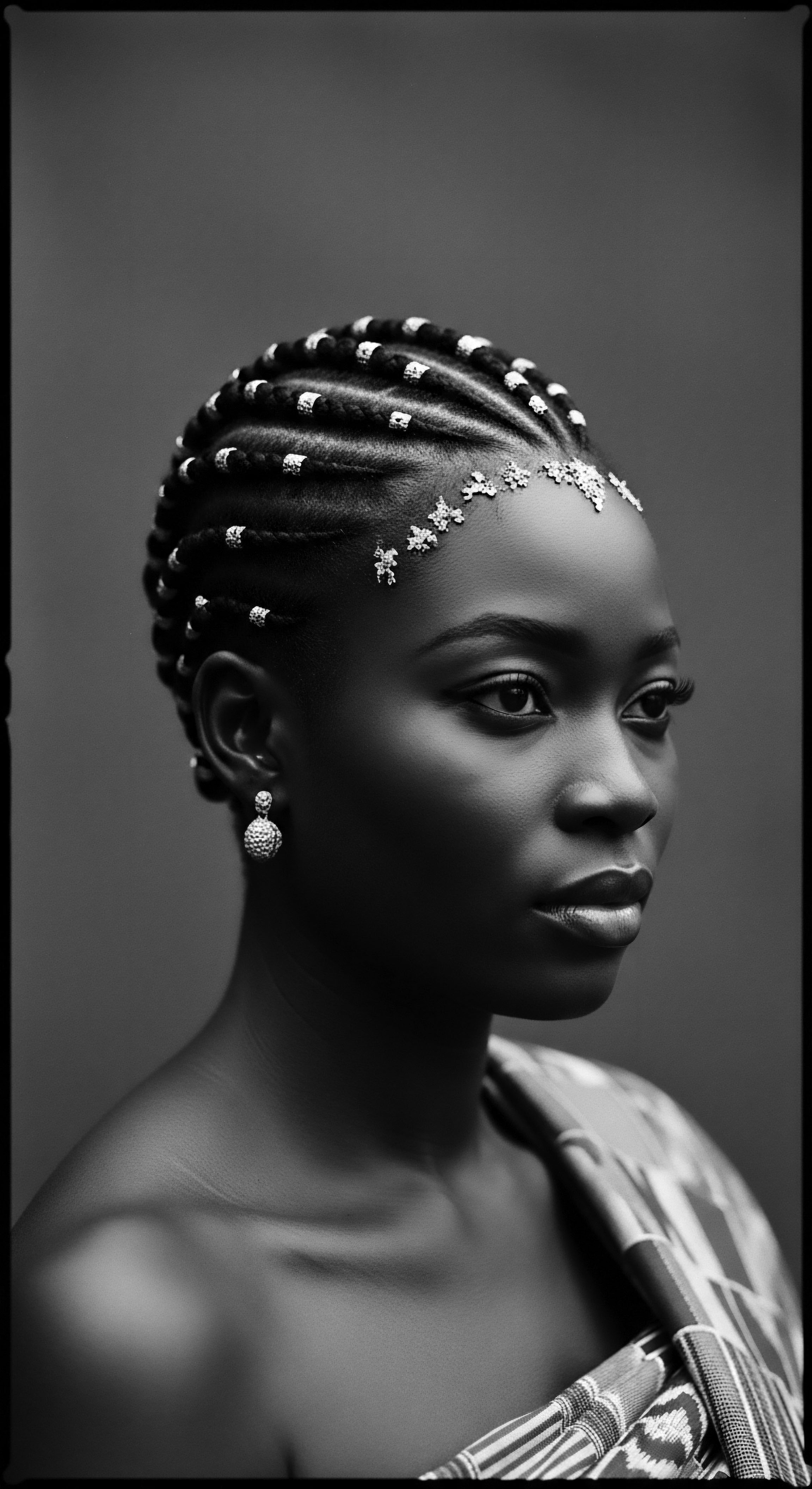
References
- Abbink, Jon. (2009). The Suri ❉ A Nomadic People in Southwest Ethiopia. Lit Verlag.
- Carretero, M. I. (2002). Clay minerals and their beneficial effects upon human health. Applied Clay Science, 21(3-4), 155-163.
- Carretero, M. I. & Pozo, M. (2009). Clay and health ❉ The therapeutic benefits of clays. Environmental Geochemistry and Health, 31(2), 297-302.
- Cole, H. M. & Aniakor, C. C. (1984). Igbo Arts ❉ Community and Cosmos. Museum of Cultural History, University of California, Los Angeles.
- d’Errico, F. & Stringer, C. (2011). The chronocultural context of the Middle Stone Age. In d’Errico, F. & Stringer, C. (Eds.), The Chronology of the Middle Palaeolithic and the Upper Palaeolithic Transition ❉ A Cultural and Chronometric Perspective (pp. 1-28). Springer.
- Ettagale, T. (1997). African Ceremonies. Harry N. Abrams.
- Hewitt, F. N. (1992). The application of mineralogy to cosmetic products. Mineralogical Magazine, 56(385), 585-591.
- Hoang-Minh, H. Le, A. & Nguyen, T. (2010). Clay minerals as a base for sunscreen cosmetic products. Journal of Cosmetic Science, 61(1), 35-44.
- Kalu, O. U. (1999). The Embodiment of God ❉ An Igbo Christian Perspective. University Press of America.
- Lydall, J. (1978). The Hamar of Southern Ethiopia. Oxford University Press.
- Mpako, K. K. Matike, E. Ekosse, G. E. & Ngole, V. M. (2011). The use of clays for cosmetic purposes in Africa ❉ An overview. 3rd International Symposium on Earth Science and Engineering.
- Omotoso, Sharon Adetutu. (2018). Gender and Hair Politics ❉ An African Philosophical Analysis. Journal of Pan African Studies, 11(7), 168-183.
- Pallington, J. (1998). The Science of Cosmetics. CRC Press.
- Rifkin, R. F. (2012). The Use of Ochre by the Himba and other African Hunter-Gatherers. University of Witwatersrand. (Doctoral dissertation).
- Rifkin, R. F. et al. (2015). Red ochre protects against solar radiation ❉ An experimental test of a Pleistocene personal ornamentation hypothesis. South African Journal of Science, 111(7/8), 1-8.
- Rosso, D. E. (2017). Ochre and human evolution ❉ A behavioral ecology perspective. Springer.
- Rudner, J. (1982). The rock art of Southern Africa. Struik.
- Sagona, A. (1994). The Caucasian region in the Early Bronze Age. Eisenbrauns.
- Ukwu, K. (2000). Igbo Women and the Earth ❉ A Socio-Economic Study. Fourth Dimension Publishing.
- Velo, J. (1984). Ochre as a therapeutic agent in pre-modern societies. Journal of Archaeological Science, 11(3), 273-278.
- Viseras, E. Lopez-Galindo, A. & Sainz-Diaz, C. I. (2007). Clays in cosmetics ❉ Historical, cultural, and scientific aspects. Clay Minerals, 42(3), 425-440.
- Willis, D. (1989). The Art of Africa ❉ Collection of the Royal Museum for Central Africa, Tervuren. Beaux-Arts.
